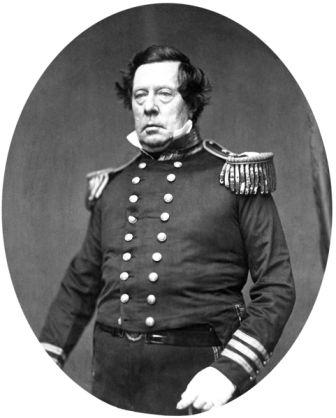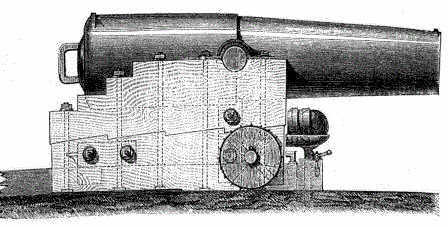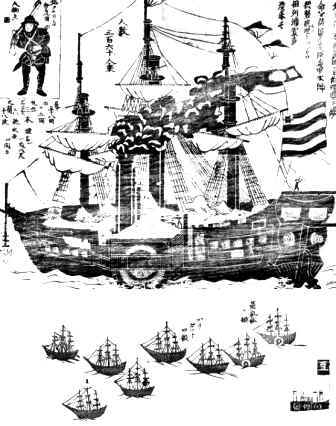|
Picture of
Commodore Matthew Perry
 |
Matthew Perry for kids: Steamships
Commodore
Matthew Calbraith Perry (1794-1858) was the younger
brother of Captain Oliver Hazard Perry (1785 –
1819)
who had fought so bravely during the Battle of Lake Erie
during the
War of 1812.
Matthew Perry was born in South Kingstown, Rhode
Island on April 10, 1794 and followed in his brother's
footsteps by following a naval career first as a young
midshipman, then as a Lieutenant and then in 1837 was
promoted to the rank of Captain and became involved in
the development of steam ships.
Matthew Perry:
"Father of
the Steam Navy"
Matthew Perry was a great innovator and pioneered the
application of steam power to warships. In 1837 Matthew
Perry was given the command of the Fulton, which was the
first steam vessel in the United States navy. Commodore
Matthew Perry became known as the "Father of the Steam
Navy" because of his commitment to introducing
steamships, powered by a steam engine, to the US Navy.
Matthew Perry: Steamships and Gunboats
The first side-wheel steamships were about 230 ft
long and had two coal-burning side-lever steam engines
that turned two paddle wheels that were 28 feet in
diameter. The new Steamboats had a crew of 260 men and carried
a new type of canon called Paixhans shell guns
effectively making the steamships powerful gunboats.
Commodore Matthew Perry for kids
In 1842 Matthew Perry was promoted to the rank of
Commodore and his early missions included command of the
African Squadron, a unit of the United States Navy that
operated to suppress the slave trade along the coast of
West Africa.
Commodore Matthew Perry: Mission to Japan
In March
1852, President Millard Fillmore ordered Commodore Matthew C. Perry to command
the U.S. Navy's East India Squadron and to establish diplomatic and trading
relations with Japan.
Commodore Matthew Perry for kids: Trading Policy of Japan
Japan had
historically operated under a policy of isolationism (called Sakoku meaning
"locked country") which prohibited contact with most outside countries. The
exceptions to this were with China, Korea and the Netherlands.
Commodore Matthew Perry: Reasons for Mission to Japan
There were
several reasons why President Fillmore initiated the expedition to
Japan by Commodore Matthew Perry:
● The
annexation of California had created an American port on the
Pacific enabling easier access between North America and Asia
● More
Chinese ports were opened to trade
● The
development of steam powered ships replaced sailing ships with
steamships allowing faster access to distant ports
● The
steamships needed to secure coaling stations, where they could
stop to take on fuel and supplies, while making the lucrative
trading trips from the United States to China
● In 1843
the British had established themselves in Hong Kong and the
United States feared losing Pacific Ocean access to Japan
Commodore Matthew Perry: The Previous Expeditions to Japan
The United
States had wanted to establish diplomatic and commercial relations
with Japan for many years. In 1846, Commander James Biddle commanded
two ships, including one warship armed with 72 cannons. The
requests of James Biddle for a trade agreement were unsuccessful. In
1849 another United States expedition commanded by Captain
James Glynn received a more favorable response and recommended to
the United States Congress that negotiations to open Japan should be
backed by a demonstration of military force to 'persuade' Japan to
open trade with America. thus paving the way for Matthew Perry's
1853 expedition to Japan.
Commodore Matthew Perry's Mission to Japan: The 1853 Expedition,
superior Military Force
Commodore Matthew
Perry's 1853 expedition to Japan was initiated by President Fillmore
in March 1852.
Commodore Matthew Perry was
given orders to break this policy of isolationism (Sakoku) by
diplomatic means. However, the new steamships were effectively
gunboats providing Matthew Perry with a superior military force,
using the latest steam engine technology that was unknown to the
Japanese. Commodore
Matthew Perry's steam engine gunships, called the "Black
Ships", were also equipped with the new Paixhans shell guns.
|
Picture of
Paixhans shell gun
 |
Commodore
Matthew Perry:
Paixhans
shell gun
Commodore
Matthew Perry's cannon were Paixhans shell guns, the
first naval gun designed to fire explosive shells. The
barrel of the Paixhans shell gun weighed about 10,000
lbs. (4.5 metric tons), and proved accurate to about 2
miles. The Paixhans shell guns were capable of wreaking
havoc and great destruction with every shell. The United
States Navy equipped several ships with 8-inch and
10-inch Paixhans shell guns including those in the fleet
of Commodore Matthew Perry.
Commodore
Matthew Perry:
Paixhans
shell gun
Paixhans shell guns were used on the USS Mississippi (10
Paixhans guns), and USS Susquehanna (6 Paixhans guns)
during Commodore Perry's mission to open Japan in 1853.
Commodore Matthew Perry's Black Ships: "Giant dragons puffing smoke"
The "Black
Ships" was the name given to all Western vessels trading with Japan.
The first "Black Ships" arrived in Japan in 1543, owned by the
Portuguese. Portugal initiated the first contacts with Japan,
establishing a lucrative trade route linking Goa to Nagasaki until
they were expelled in 1639. The large Portuguese carracks had the
hull of their ships painted black with pitch, and the term came to
represent all vessels used by western foreigners. The term "Black
Ships" therefore at first referred to the black color of the hull of
older sailing vessels. The same term was applied to Commodore
Matthew Perry's vessels. Matthew Perry's "Black Ships" were
also painted with black hulls but they also had black smoke from the
coal-fired power of the American ships. The Japanese had never seen
a steam powered ship, likening Matthew Perry's "Black Ships"
as "Giant dragons puffing smoke", the Paixhans would have
demonstrated that the "dragons" also had the power to breath fire.
The term "Black Ships" would later be used in Japan to symbolize a
threat imposed by Western technology.
Commodore Matthew Perry's Mission to Japan: The Emperor and the
Shogun
Commodore Matthew Perry's mission to Japan coincided with a weak Japanese
government. The Japanese ruler, Emperor Komei only possessed symbolic power at
his court in Kyoto. The real power in the government of Japan was held by the
Tokugawa Shogunate, a political form of dictatorship by the Japanese feudal
lords whose power was based in their military force. The head of the Shogunate
was Tokugawa Iesada who was the 13th hereditary Shogun. The Shogun was the real
ruler of Japan, supported by Samurai warriors. The Shogun at the time of Matthew
Perry's Mission to Japan was Tokugawa Ieyoshi, but the 60-year-old shogun died
soon after Matthew Perry's fleet arrived and his son
Tokugawa Iesada assumed the position of
Shogun in 1853. The new Shogun, Tokugawa Iesada, was physically weak lacking
neither experience nor strong qualities of leadership.
Commodore Matthew Perry Demands that Japan becomes open to Trade:
The 1853 Expedition
Commodore Matthew Perry arrived in Japan in 1853
to open diplomatic and commercial relations
between Japan and the United States. The 1853 expedition consisted of in command
of the East India Squadron consisting of four frigates (all with black hulls),
the Mississippi, Plymouth, Saratoga, and Susquehanna.
Matthew Perry had researched the culture of the
Japanese and knew of the political and military instability of Japan due to the
new Shogun. Matthew Perry was met by representatives of the Tokugawa Shogunate
who told him to proceed to Nagasaki, the only Japanese port open to foreigners.
Matthew Perry made a forceful impact on the Japanese by refusing to enter
the foreigners' port of Nagasaki by proceeding directly to Uraga, near the
Shogun's capital of Edo (Tokyo) bay. Matthew
Perry Entering Edo Bay on July 2, 1853 with 967 men on his four war ships
with sixty-one guns. Commodore Matthew Perry demanded that Japan open its ports
to trade with the United States. His war ships were larger than any the Japanese
had seen, and their dark hulls and black smoke emphasized the name of the "Black
Ships." He then ordered some buildings in the harbor of Uraga to be shelled by
the Paixhans, intimidating the Japanese and demonstrating the military power of
the United States. Matthew Perry demanded negotiations on his own terms and
declared that he would return the following year to receive the Japanese
response to the letter from the President Millard Fillmore, to the Emperor of
Japan. Matthew Perry left Japan on the July 14, 1853.
|
Excerpts from an
1854 Japanese print relating to Matthew Perry's visit

|
Matthew Perry 1854 Expedition: Japanese Expedition Fleet
The Matthew Perry Japanese expedition of 1854 consisted
of eight war ships supported later by a supply ship. The
names of the war ships on the 1854 expedition were:
● The Powhatan -
the Flag ship (Steamship)
● The Susquehanna
(Steamship)
● The Mississippi
(Steamship)
● The Macedonian
(Sailing ship)
● The Saratoga
(Sailing ship)
● The Southampton
(Sailing ship)
● The Vandalia
(Sailing ship)
● The Lexington
(Sailing ship)
The picture on your right depicts excerpts from an 1854
Japanese print relating Matthew Perry's visit featuring
the Powhatan flag ship and the other ships that formed
the Japanese expedition fleet. The American ships were
manned by a total of 1600 men.
Matthew Perry 1854 Expedition:
Convention of Kanagawa
Matthew Perry arrived in Japan on February 13,
1854 and was met with Japanese officials at the
Convention of Kanagawa to discover that the Japanese
had conceded to nearly all the
terms in President Fillmore's letter.
The Treaty of Kanagawa
between the United States and Japan was signed on
March 31, 1854.
Commodore Matthew Perry's Mission to Japan for kids - President Millard Fillmore Video
The article on the
Commodore Matthew Perry's Mission to Japan provides an overview of one of the Important issues of his presidential term in office. The following
Millard Fillmore video will
give you additional important facts and dates about the political events experienced by the 13th American President whose presidency spanned from July 9, 1850 to March 4, 1853.
Commodore Matthew Perry's Mission to Japan
●
Interesting Facts about Commodore Matthew Perry's Mission to Japan for kids and schools
●
Definition of the Commodore Matthew Perry's Mission to Japan in US history
●
The Commodore Matthew Perry's Mission to Japan, a Important
event in US history
●
Millard Fillmore Presidency from July 9, 1850 to March 4, 1853
●
Fast, fun, interesting
facts
about the Commodore Matthew Perry's Mission to Japan
●
Foreign & Domestic
policies of President Millard Fillmore
● Millard Fillmore Presidency and
Commodore Matthew Perry's Mission to Japan for schools,
homework, kids and children
|